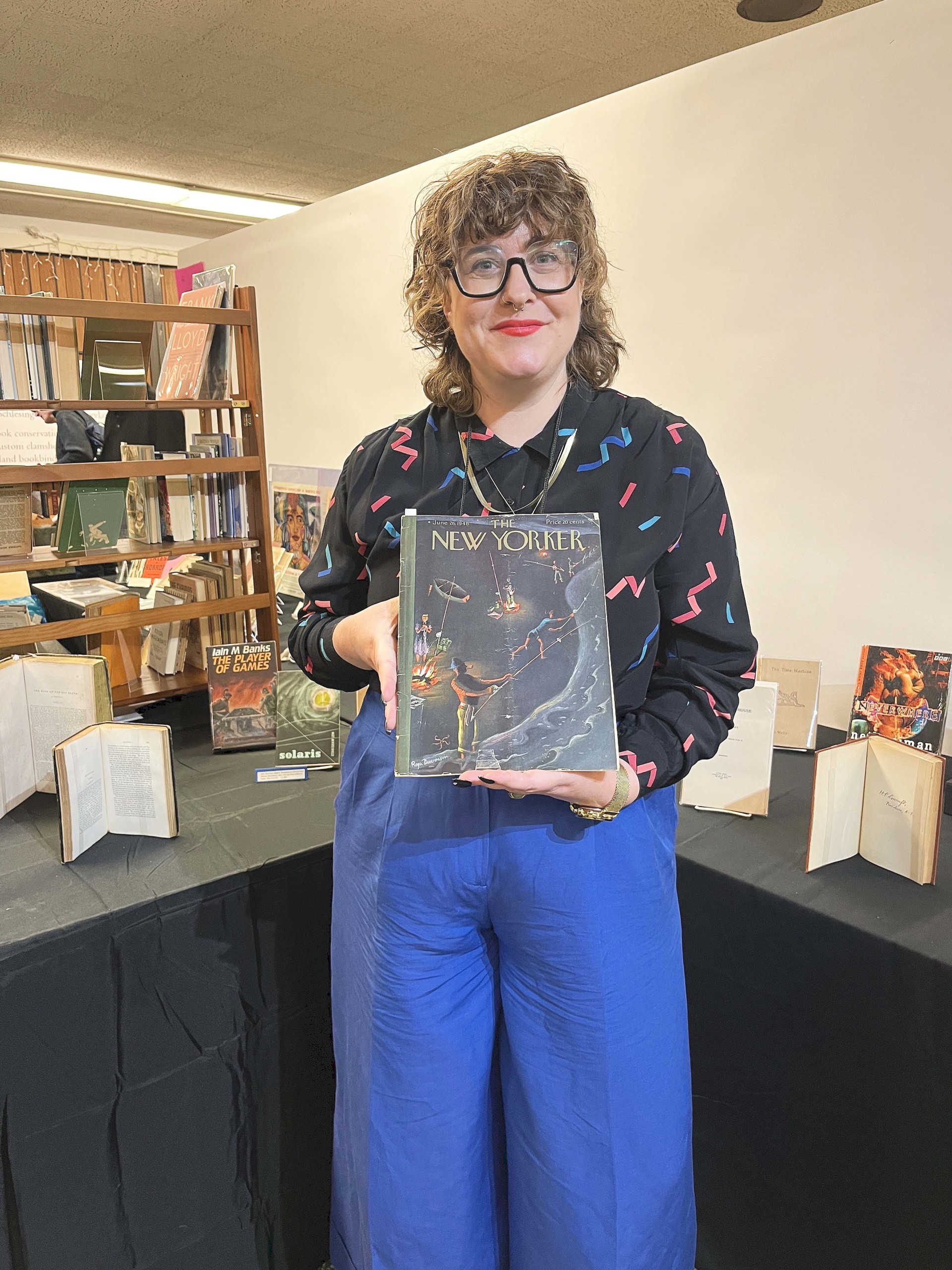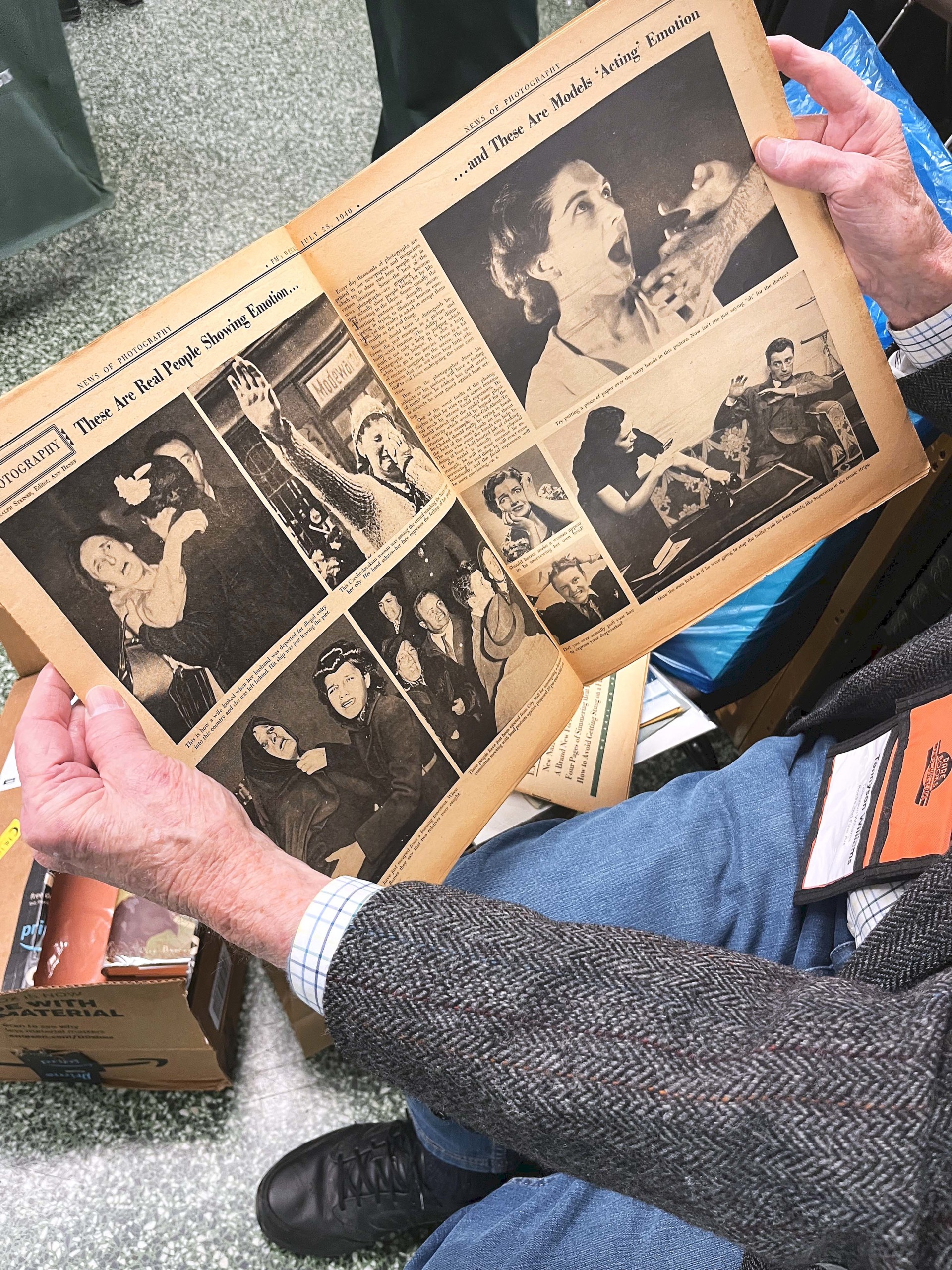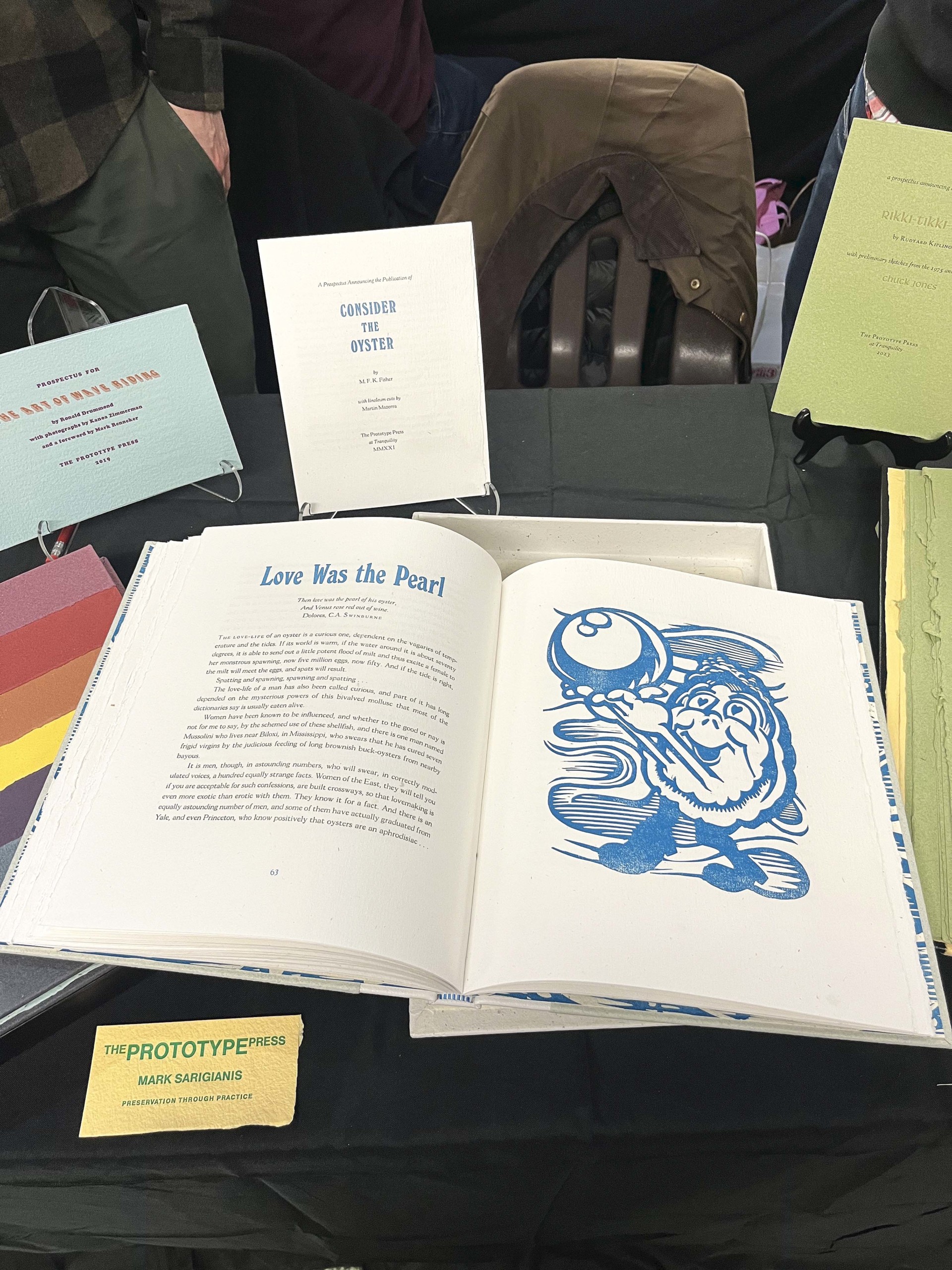
Caroline Schimmel with Mabel Loomis Todd’s Corona and Coronet.
Review & Onsite Photos by Laura Preston
NEW YORK CITY — April, in Manhattan, is a month of arrivals. As the city thaws, the daffodils return, and so do the ice cream carts, the first hints of fine weather and the rare book dealers, who descend on the island for their most important date of the year. Their destination is the New York International Antiquarian Book Fair (NYIABF), which turns the Park Avenue Armory into a maze of vitrines replete with rare wonders: celestial atlases, Books of Hours, Birds of America and folios to make an early Modernist faint. But books that make the jaw drop often have prices that do the same. Luckily for book lovers of modest means, there is another fair across the street.
In the basement of the Church of St Vincent of Ferrer, one will find the Manhattan Rare Book and Fine Press Fair, known colloquially as “The Shadow Fair.” Here, the prices are down to earth, and the offerings, said one buyer, “more imaginative.” Those who know books know about this fair, which is now in its 20th year, took place on April 6. A line formed well before the 9 am opening and many of the early birds had booths at “the big one,” across the street.
In contrast to the Armory’s rarefied atmosphere, the Shadow Fair has an intimate feel. The ceilings are low and the floors are linoleum; this church basement looks like a church basement. Upon entering, the first table one would encounter is the security table, which was piled high with confiscated paperbacks to be returned when the shopping was done. An anti-theft measure, to be sure, but also an incidental portrait of the fair’s clientele: subway readers, all of them.

Nancy Cunard’s Parallax and Virginia Woolf’s A Writer’s Diary from Leslie Arthur of Second Wind Books. New Haven, Conn.
One of the first booths by the entrance was Greg Gibson from Ten Pound Island Book Co,. of Gloucester, Mass. Gibson specializes in maritime history and had a number of beautiful items on display, including the 1854 log of the whaling ship William Tell, a Hawaiian-language bible from 1842 and a Nineteenth Century botanical album of pressed sea mosses.
Caroline Schimmel, a full-time book collector and bibliographer, was eagerly browsing the offerings. A Victorian penny dreadful caught her eye: Narrative and Confessions of Lucretia P. Cannon, which tells the story of a female serial killer. After a think, Schimmel walked away with a different book, this one with a contemporary tie-in: Mabel Loomis Todd’s Corona and Coronet, which narrates an 1896 sea journey to Hokkaido, Japan, to witness a solar eclipse.
Nearby, Leslie Arthur from Second Wind Books of New Haven, Conn., presented an attractive display of Modernist texts with an emphasis on Virginia Woolf and the Bloomsbury group. On offer were a number of first editions by Woolf, including a first American printing of Orlando signed in Woolf’s iconic purple script. “I freaking know everything about Virginia Woolf,” said Arthur. “Even the years she had her teeth pulled out.” Of particular interest was a first edition of Nancy Cunard’s poetry collection Parallax, which was published in 1925 by Virginia and Leonard Woolf’s Hogarth Press. The book’s type was set by Virginia, while Leonard inked the galleys. “His hands shook,” said Arthur. She pointed out a few stray smudges in the margins — evidence of Leonard’s tremors. “I think there’s a thumbprint in here,” she said.

Kat Baird of The Book Bin with the 1948 issue of The New Yorker that first ran Shirley Jackson’s controversial short story “The Lottery.” Salem, Ore.
Many sellers at the Shadow Fair had curated their selections around a special area of interest. Around the corner from Arthur’s booth, Obadiah and Kat Baird from The Book Bin of Salem, Ore., were presenting a nicely curated array of science fiction and fantasy titles. Among their offerings were a first edition of Solaris by Stanisław Lem, a number of literary journals with early Edgar Allen Poe appearances and the June 26, 1948, edition of The New Yorker magazine, which first ran Shirley Jackson’s short story “The Lottery.” Fans of Jackson will know that the story caused an uproar and an influx of angry letters. “Among the hate mail was a letter from her own mother,” said Obadiah.
Other vendors at the fair were generalists. One such was Robin Cohen, who was representing University Archive of Wilton, Conn., the company founded by handwriting expert David Reznikoff. University Archive’s offerings run the gamut of historical documents, letters, autographs — and, said Cohen, hair. Reznikoff is in the Guinness Book of World Records for the largest collection of human hair. He has locks from Lincoln, Marilyn Monroe and Kurt Cobain. “He does sell it,” said Cohen. “You can break it apart.” But they brought no hair to the Shadow Fair, just Civil War letters and signed ticket stubs. (Reznikoff himself, said Cohen, “was across the street,” at NYIABF.

David Morse of Better Read than Dead with a note from Joe Brainard. Brooklyn, N.Y.
A few steps away from the University Archive table, a group of Harvard librarians were browsing the ephemera collections of Better Read Than Dead, a bookshop that operates out of a shipping container in Brooklyn, N.Y. Better Read Than Dead’s booksellers have eclectic tastes ranging from African American history to leftist political movements, art, counterculture and the New York School of poets. One centerpiece of their display was a handwritten note from artist and writer Joe Brainard. Bookseller Dave Morse said that the note emerged from an enormous lot of ephemera that had passed through the hands of several dealers before reaching their shop. The lot had been like a Ship of Theseus: ambitious dealers would attempt to catalog its 20,000 pieces of paper but eventually give up before reaching the bottom. Each dealer would keep some items, leave some of their own and pass the lot along to the next intrepid optimist. The Brainard letter was the latest treasure to surface, but there was more yet to sort back in Brooklyn.
Another generalist was Richard Chalfin from The Chatham Bookseller of Chatham, N.J. Chalfin is a fourth-generation bookseller. “My great-grandfather sold books in a backpack in Russia, near Odessa at the turn of the century,” he said. The pride of Chalfin’s booth was a once-in-a-lifetime find: a first edition of The Great Gatsby, which he had acquired just a few days earlier. He was proud to be offering it at the Shadow Fair. “I’ve been in the business for 45 years, and I’ve never even seen a copy,” he said. “You’re more likely to see one across the street, at the big enchilada.”

Tennyson Williams shows off his collection of PM. Williamsburg, Va.
Opposite Chalfin’s booth, another generalist, Tennyson Williams, from Tennyson Williams Rare Books of Williamsburg, Va., was selling everything from land grants to pop-up books. “I specialize in whatever the most recent collection I happen to buy is,” he said. His latest rabbit hole was New York’s PM, a daily leftist newspaper that published from 1940 to 1948 and whose staff photographers included Irving Haberman and Margaret Bourke-White. Williams had a stash of original press photos from PM he was cataloging, and they were wonderful, evocative images.
Photography was well-represented at the Shadow Fair. Stacy Waldman, from House of Mirth Photos of Easthampton, Mass., had arrived with her characteristically offbeat array of captivating items. Waldman has a brilliant eye for eccentric characters, found collections and artifacts of a peculiar human pathos. Among her highlights were the diaries of a sadomasochistic sex worker, a Victorian burl wood sewing box with inset portraits and an anonymous snapshot album documenting 1960s-era product packaging. Also specializing in photographic materials was Erin Waters from Erin Waters Fine Photographs of Lancaster, Penn., who had brought a number of remarkable ambrotypes, including a portrait of a blind African American man that sold quickly. She also shared a charming homemade album from the 1930s documenting the lives of a pair of twin boys. Like Waldman, Waters has a special talent for finding rare, ineffable images that probe the human psyche.

Prototype Press’s edition of M.F.K. Fisher’s Consider the Oyster. Southern Maryland.
The Shadow Fair distinguishes itself from other fairs of its kind in that a portion of the show is dedicated to small presses. Esther K. Smith and Dikko Faust, from Purgatory Pie Press, of New York City, had an especially attractive setup, with hand-colored posters designed by British artists Bob and Roberta Smith, handmade book-shaped earrings and Cartesian Lace Bricolage – an impressive sculptural book in the shape of a sine curve, which was made in collaboration with artist Susan Happersett. Purgatory Pie Press has been in business since the 1970s; Smith and Faust do all of the typesetting, printing and binding themselves. Smith has also authored a number of popular books on bookmaking, which have been published by Random House and Rizzoli, and which were on offer at their booth.
Nearby, Prototype Press of Indian Head, Md., had brought a delightful, tongue-in-cheek edition of M.F.K. Fisher’s Consider the Oyster, which came with its own oyster knife. Nawakum Press, of Gig Harbor, Wash., presented A Bonsai-Shaped Mind, Marc Peter Keane and Richard Wagener’s homage to bonsai, which won the show’s Collector’s Prize. Also among the small press tables were individual artists, like Nancy Loeber, of Brooklyn, N.Y., who designed, typeset, bound and illustrated gorgeous, limited printings of short stories by George Saunders, Miranda July and others.
Though the basement of the Church of St Vincent of Ferrer has just a fraction of the Armory’s square footage, the show felt immersive and exhaustive — a veritable adventure for the collector who enjoys the search as much as the find. Anyone who is serious about antiquarian books will know that the show at the armory is a given. But wise collectors will not neglect the Shadow Show. “We had a terrific turnout, with nearly 1,000 people through the door. Exhibitors reported robust sales — in fact, one sold a book for $65,000, and many said it was their best book fair ever,” said Jen Johnson, the fair’s communications director. She confirmed the 2025 edition would take place on Saturday, April 5. For information, www.rarebooksla.com/index.php/new-york.


















